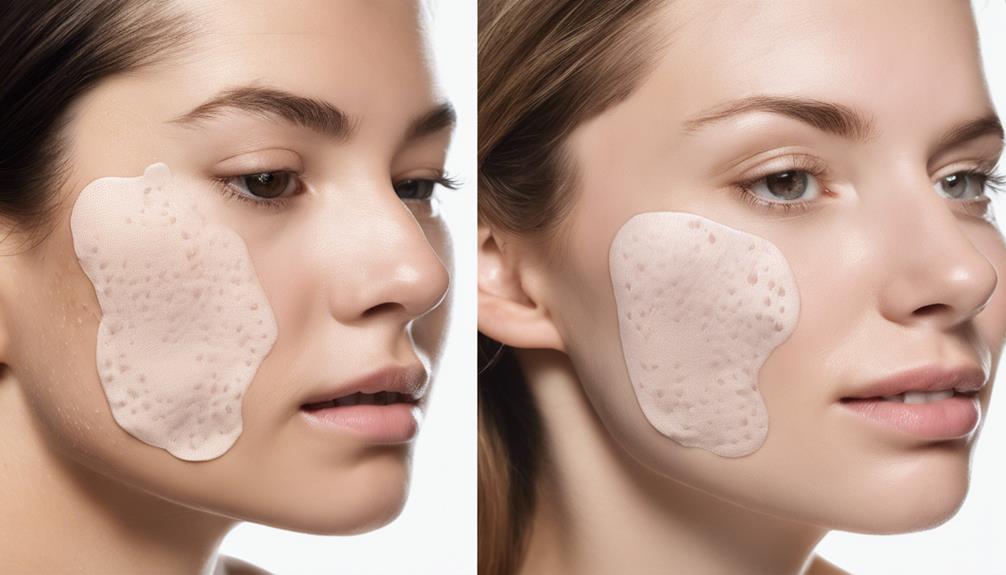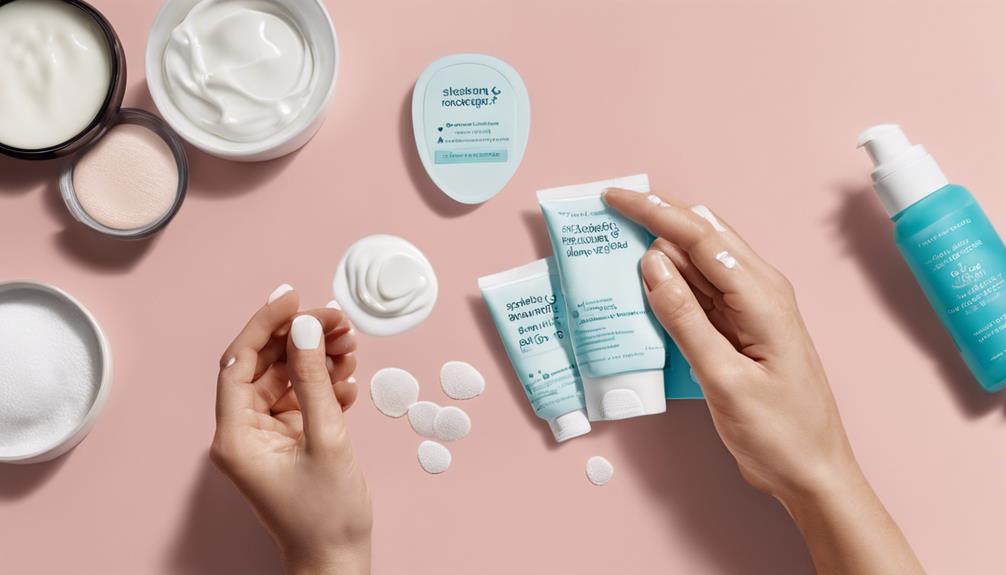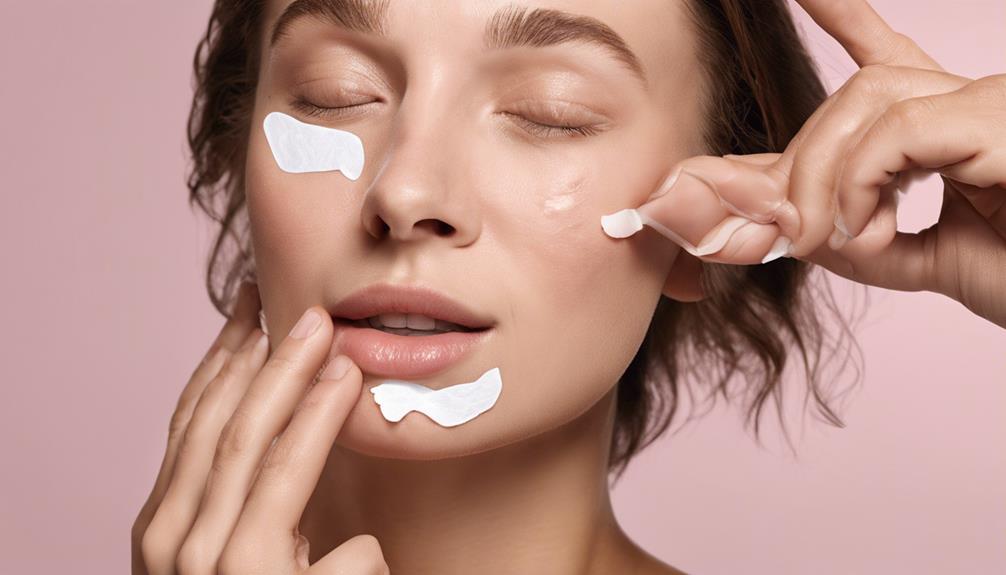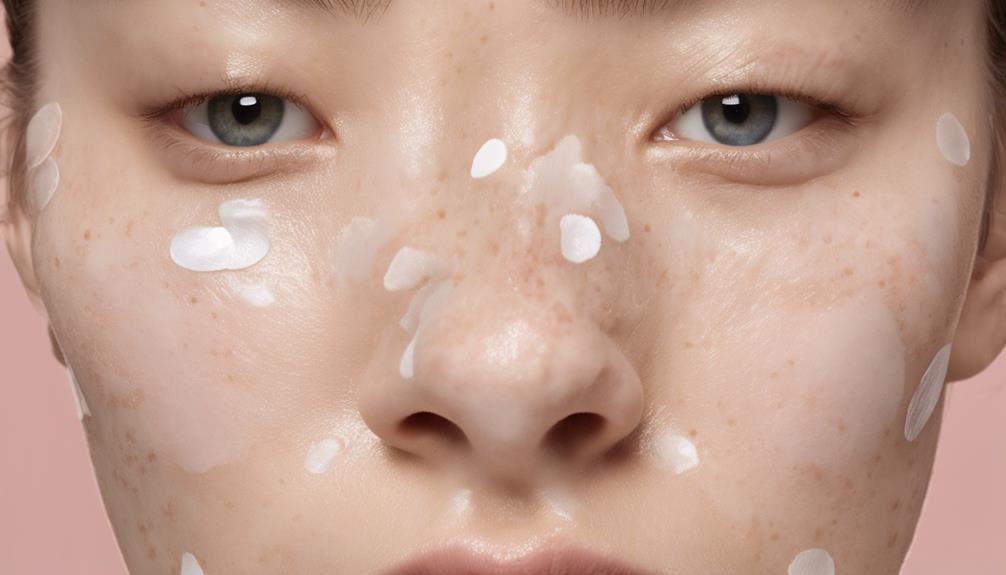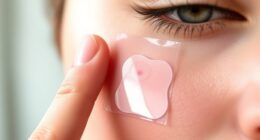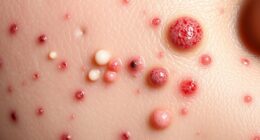Pimple patches turn white because they absorb excess fluids like sebum and pus, actively aiding in the healing process. Hydrocolloid in the patch acts as a sponge, drawing out impurities and moisture. This absorption causes the patch to change color, indicating its effectiveness. The white substance isn’t extracted pus but moisture, creating an ideal environment for recovery. Understanding this color change reveals the patch’s role in treating blemishes. For a deeper insight into why pimple patches turn white, explore the fascinating mechanism of hydrocolloid absorption and how it benefits pimple healing.
Key Takeaways
- White transformation signifies absorption of excess fluids like sebum and pus.
- Hydrocolloid acts like a sponge, drawing out impurities and moisture.
- The white color demonstrates active absorption, aiding in faster healing.
- Patches create a moist environment for blemish recovery.
- White patches show the effective treatment process, not extracting gunk from pores.
The Science Behind Pimple Patch Color Change
As we explore the science behind pimple patch color change, it becomes evident that the white transformation signifies the absorption of excess fluids like sebum and pus from the pimple.
This change occurs due to the hydrocolloid in the patch, which acts like a sponge, absorbing impurities and moisture from the skin.
The patch turns white as the hydrocolloid absorbs these fluids, creating an opaque appearance that shows the active absorption process at work.
It's essential to remember that the white substance on the patch isn't extracted pus but rather moisture from the skin, helping to maintain a moist environment conducive to healing.
Factors Contributing to White Patches
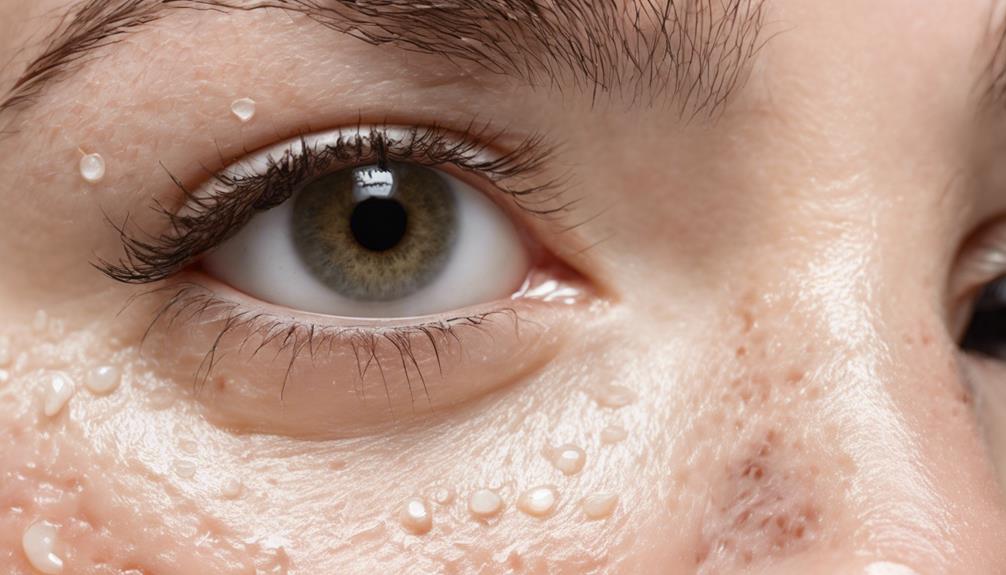
Indisputably, various factors contribute to the formation of white patches on pimple patches, revealing the effectiveness of the absorption process.
When pimple patches come into contact with the blemish, the hydrocolloid material within them starts to absorb excess fluids such as sebum and pus. As this absorption occurs, the hydrocolloid swells and turns white, indicating that impurities are being drawn out from the pimple.
The white substance visible on the patch is actually the hydrated hydrocolloid, not extracted pus, showcasing the patch's ability to absorb fluids effectively. This process not only reduces inflammation by removing excess fluids but also creates an ideal environment for the skin to heal faster.
Therefore, the white color that pimple patches turn serves as a visible sign of the amount of fluid being absorbed and the active treatment process that's underway, ultimately aiding in the healing of the blemish.
Understanding Pimple Patch Absorption Process
Exploring the absorption process of pimple patches reveals why they turn white as they effectively draw out excess fluids from blemishes. Pimple patches contain hydrocolloid, a material known for its ability to absorb impurities like excess sebum and pus. As the hydrocolloid absorbs these fluids, it swells and becomes opaque, causing the patch to turn white. This white substance on the patch is actually hydrated hydrocolloid, creating a moist environment that supports the healing process.
To better understand this absorption process, let's visualize it through the following table:
| Absorption Process of Pimple Patches |
|---|
| Hydrocolloid absorbs excess sebum and pus from the pimple |
| Swells and becomes opaque during absorption |
| Creates a moist environment for healing |
| Turns the patch white as impurities are drawn out |
| Maintains a conducive environment for faster blemish healing |
Understanding how pimple patches absorb excess fluids sheds light on why they turn white, signaling their active role in promoting healing.
Mechanism of Action for Pimple Patches
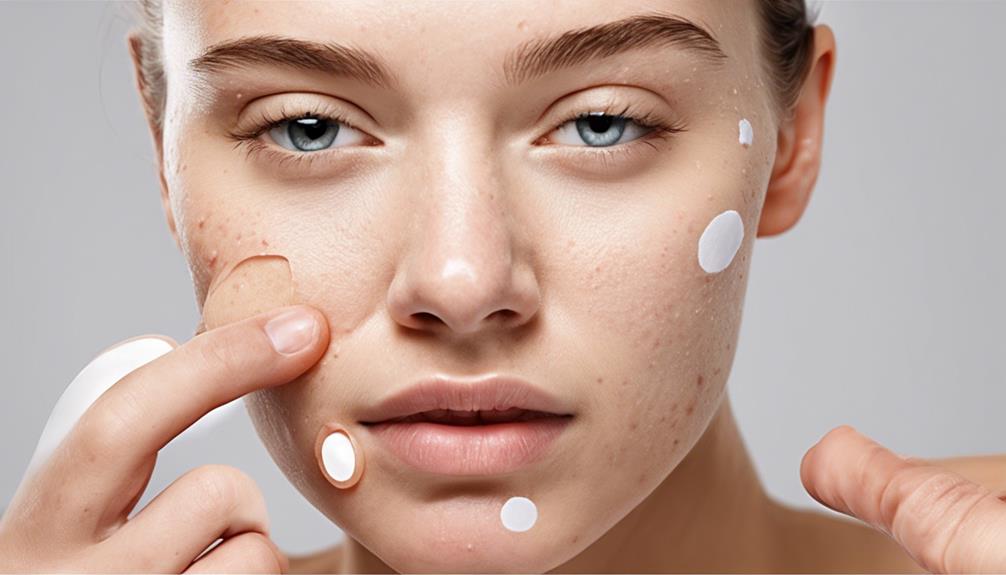
Pimple patches work by absorbing excess fluids like sebum and pus from the pimple, promoting the healing process.
The hydrocolloid in the patches swells as it absorbs impurities, turning white to indicate active absorption.
This mechanism helps maintain a moist environment for skin healing without extracting gunk from deep within pores.
Patch Absorbs Pimple Contents
Absorbing excess sebum, pus, and fluids from the pimple, the patch turns white as it actively works to draw out impurities and promote healing. The white stuff you see on the patch is a sign that it's doing its job by absorbing these impurities.
Hydrocolloid helps in this process by acting like a sponge, pulling out the gunk from the pimple. This aids in preventing contamination and forming a protective barrier over the affected area. By capturing fluids and creating a moist environment, the patch supports faster healing and reduces inflammation.
Promotes Healing Process
Promoting the healing process, pimple patches actively draw out impurities and reduce inflammation to support faster recovery. The hydrocolloid patches work by absorbing excess fluids like pus and sebum, creating a moist environment that aids in healing. As the patch absorbs impurities, it swells and turns white, indicating its effectiveness in pulling out impurities. This process not only helps in reducing inflammation but also minimizes redness and the raised appearance of pimples. By creating a barrier that absorbs excess fluids, the patch supports the natural healing process of the skin, promoting a quicker recovery. Check out the table below for a simplified breakdown of how pimple patches work:
| Action | Effect |
|---|---|
| Absorbs excess fluids | Reduces inflammation |
| Creates moist environment | Supports faster recovery |
| Pulls impurities out | Minimizes redness and raised pimples |
Why Pimple Patches Turn White

Pimple patches turn white due to their absorption of excess fluids like sebum and pus, showcasing their active impurity removal process. The hydrocolloid in the patches swells as it absorbs impurities, leading to the opaque white appearance of the patch.
This color change signifies that the patch is effectively creating a healing environment by reducing inflammation in the pimple.
Sebum Absorption Process
While enhancing the clarifying process of pimple patches, the sebum absorption mechanism plays an essential role in turning them white. These patches work by absorbing excess sebum, which is the oily substance produced by the skin.
As the patch absorbs this sebum, along with pus and fluids from the pimple, it turns white. This change in color indicates that the patch is actively absorbing impurities, such as bacteria and other contaminants, from the pimple.
The absorbed sebum and impurities cause the patch to swell and become opaque, visibly showing that it's working to draw out these substances. Ultimately, the white patch helps in reducing inflammation, redness, and the raised appearance of pimples, promoting clearer skin.
Hydrocolloid Reaction Explanation
In understanding why pimple patches turn white, it is important to explore the hydrocolloid reaction explanation. When the hydrocolloid material in the patch comes into contact with excess fluids like sebum and pus from the pimple, it begins its absorption process. This reaction causes the hydrocolloid to turn into a gel-like substance, appearing white on the patch's surface. The whiteness signifies the active absorption of impurities, creating an ideal moist environment for faster healing. As the patch continues to absorb more fluids, it becomes whiter, indicating its effectiveness. Replacing the patch when it turns white is essential for maintaining its absorbent properties and promoting the healing process.
| Hydrocolloid Reaction | Absorption | Excess Fluids |
|---|---|---|
| Gel-like substance | Active absorption | Sebum and pus |
The Significance of White Patches
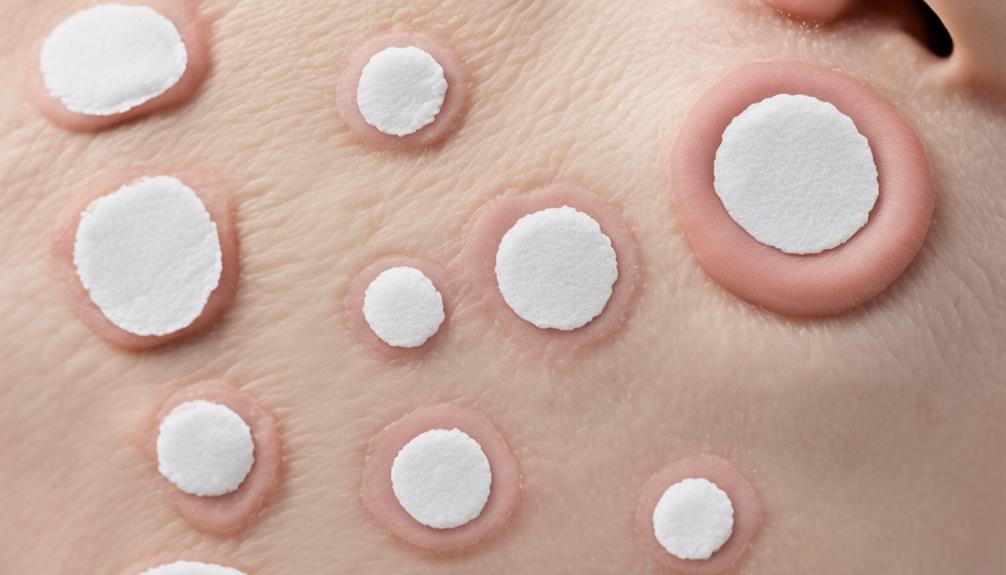
The appearance of white patches on pimple patches signifies the active absorption of excess fluids. When the hydrocolloid patch turns white, it shows that it's working to create a moist environment for the healing process of the blemish.
Here are some reasons why the white patches are significant:
- Moist Wound Environment: The white substance on the patch is hydrated hydrocolloid, not extracted pus, which aids in reducing inflammation and promoting faster recovery.
- Fluid Absorption: As the patch absorbs more fluids, it turns whiter, demonstrating its effectiveness in treating the pimple.
- Healing Support: The primary function of the white patches is to maintain a moist wound environment, which helps in the healing process and reduces the appearance of the pimple.
- Visible Effectiveness: The color change to white allows you to see that the patch is actively working to draw out excess fluids, indicating progress in treating the pimple.
The Role of Hydrocolloid in Patch Color Change

Hydrocolloid in pimple patches works by absorbing excess fluids like sebum and pus from pimples. As it absorbs these impurities, the patch material reacts, causing a color change to white.
This change in color is a visual indicator that the hydrocolloid is actively absorbing and drawing out the impurities from the pimple for faster healing.
Hydrocolloid Absorbs Sebum
When sebum is absorbed by the hydrocolloid in pimple patches, a noticeable color change occurs, indicating the removal of excess oil from the skin. This process is important for helping the pimple heal effectively.
Here are some key points about how hydrocolloid absorbs sebum in pimple patches:
- Hydrocolloid acts like a sponge, drawing out sebum from the pimple.
- The absorbed sebum helps in reducing inflammation and redness.
- Removing excess sebum prevents the pimple from worsening.
- The white color of the patch shows that the hydrocolloid is actively working to cleanse the pimple.
Patch Material Reacts
Upon reacting with wound fluids, pimple patches containing hydrocolloid material undergo a color change to white as they absorb excess sebum and pus from the affected area. The hydrocolloid in the patch reacts with the impurities, turning white as it draws them out, promoting a healing environment. This color transformation signifies the active absorption process occurring beneath the patch. The gel-forming properties of hydrocolloid create a barrier that aids in maintaining the moisture balance while extracting impurities. The white appearance serves as a visual indicator that the patch is effectively working to cleanse the skin. Below is a table illustrating the relationship between patch material reaction and the resultant white color change.
| Patch Material Reacts | Hydrocolloid | White |
|---|---|---|
| Color Change | Absorbs fluids | Indicator of effectiveness |
Color Indicates Absorption
The color change to white on pimple patches signifies the active absorption of fluids like sebum and pus by the hydrocolloid material. Here are some key points to help you understand how the hydrocolloid works in changing the color of the patch:
- Hydrocolloid in the patches absorbs excess fluids, turning into a jelly-like mass and changing color to white.
- The more fluid the patch absorbs, the whiter it becomes, signaling the need for replacement.
- The white substance on the patch is hydrated hydrocolloid, not extracted pus, showing the effectiveness of the patch.
- The primary function of the white color change is to demonstrate the amount of fluid absorbed for best healing of blemishes.
How Pimple Patches Remove Impurities
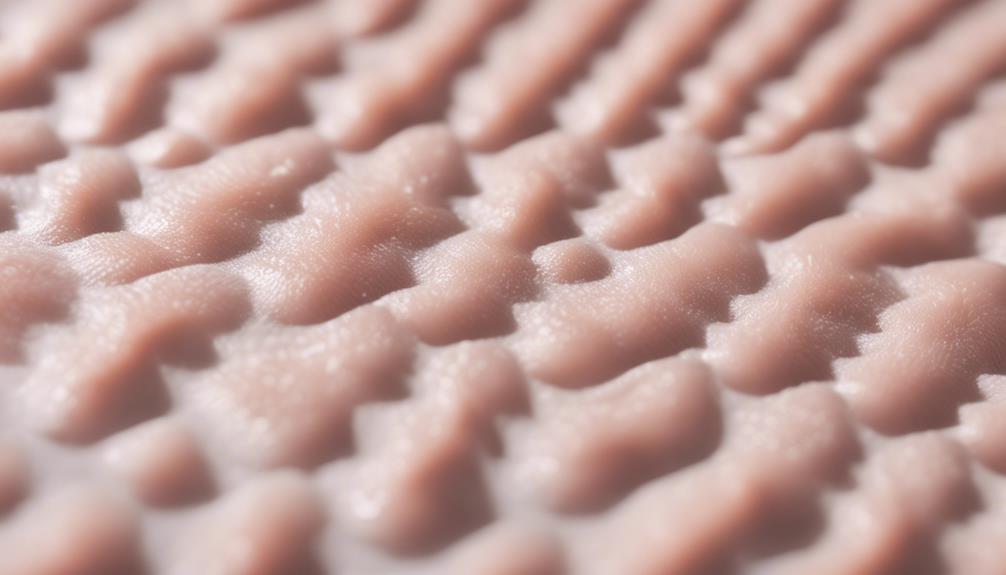
By using pimple patches, you aren't only targeting the pimple directly but also creating an ideal environment for your skin to heal efficiently. It's crucial to understand that the white substance on the patch isn't extracted gunk from the pore but rather the absorbed fluids from your skin.
These patches help reduce inflammation and promote faster healing by maintaining a clean and moist environment that supports the skin's natural recovery process. The white color you see on the patch is a result of this absorption, indicating that the patch is actively working to draw out impurities.
The hydrocolloid material in the pimple patches acts like a sponge, attracting impurities and creating a moist environment that aids in the healing process.
The Transformation of Pimple Patch Color

As pimple patches absorb excess fluids, their color undergoes a noticeable transformation to white. The hydrocolloid material in the patch works actively to absorb impurities like sebum and pus from the pimple, leading to the change in color. Here are some key points to understand this color transformation:
- The white color indicates the active absorption of impurities and fluids by the hydrocolloid material.
- Monitoring the transformation to white helps gauge the effectiveness of the patch in treating the pimple.
- Hydrocolloid patches create a moist environment for healing, turning white as they work to absorb impurities.
- The white color of the patch isn't pus but a result of the absorbed fluids, showing that the patch is actively treating the pimple.
Understanding how the color changes can help in tracking the progress of the patch in treating the pimple effectively.
Benefits of White Patches on Pimple Patches
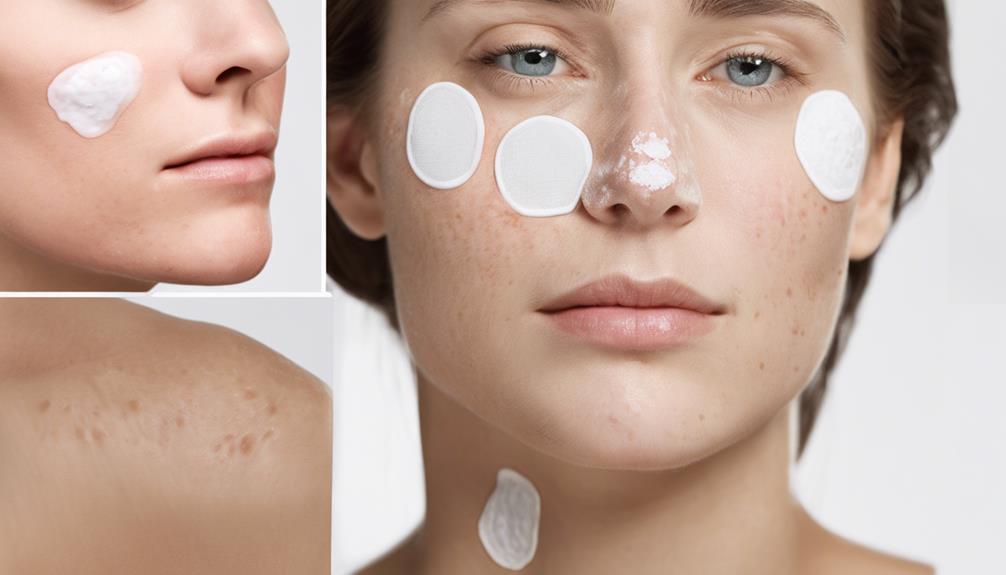
Indicating active absorption, the white patches on pimple patches signal effective impurity removal and faster healing. These white spots are a positive sign that the hydrocolloid material in the patch is working diligently to draw out excess fluids like sebum and pus from the pimple.
As the hydrocolloid absorbs impurities, it turns opaque and creates a moist environment that promotes quicker healing. By turning white, the pimple patch demonstrates its effectiveness in reducing inflammation and supporting the skin's natural healing process.
It's important to note that the white substance visible on the patch isn't pus but rather hydrated hydrocolloid, which helps maintain an ideal environment for healing without causing harm. Embracing the white patches on pimple patches means embracing the power of absorption and healing, as these patches work tirelessly to serve your skin's well-being and restore its natural balance.
Frequently Asked Questions
Do Pimple Patches Work on Unpopped Pimples?
Pimple patches are effective on unpopped pimples as they create a protective barrier, absorb excess fluids like sebum and pus, reduce inflammation, and promote faster healing.
The white color on pimple patches indicates active absorption of fluids, not extracted gunk.
Using pimple patches on unpopped pimples can prevent infection, scarring, and further breakouts.
Is It Bad to Leave a Pimple Patch on Too Long?
Leaving a pimple patch on for too long can reduce its effectiveness. It may lead to detachment, losing the protective barrier over the pimple. Extended wear can also cause the patch to lose its adhesive properties, risking slipping off. To ensure optimal results, it’s important to understand how long to wear pimple patches. Most experts recommend leaving them on for 6 to 8 hours, allowing enough time for the active ingredients to penetrate the skin and absorb impurities. Additionally, removing the patch too soon may prevent it from fully drawing out excess oil and bacteria, ultimately hindering the healing process.
Skin irritation may occur if left on for an extended period, impacting its function. Following the recommended wear time is essential for best healing benefits and efficacy.
What Is the White Stuff on My Pimple?
We notice white stuff on pimples because of hydrated hydrocolloid, not pus. This substance absorbs extra fluids, aiding in the healing process.
The white color means the patch is working by drawing out impurities and reducing inflammation. It creates a protective barrier over the pimple, fostering faster recovery.
When Should You Not Use Pimple Patches?
We should avoid using pimple patches on open wounds, broken skin, areas with active eczema, dermatitis, or severe skin conditions, skin with known allergies to hydrocolloid or adhesive materials, sunburned, irritated, or extremely sensitive skin.
Consulting a dermatologist before using pimple patches is important if there are concerns about skin reactions or underlying conditions.
Prioritizing skin health and safety by following these guidelines when deciding when not to use pimple patches is key.
Conclusion
To sum up, pimple patches turn white due to the absorption of impurities and oils from the skin. While some may be surprised by the color change, it's a sign that the patch is working effectively to draw out the blemish-causing elements.
So, the next time you see your pimple patch turn white, rest assured that it's doing its job to help clear your skin. Trust the process and let the patch work its magic.

